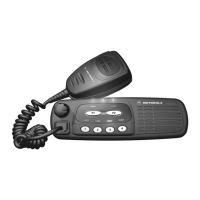Chapter 3: 1-4 Controller Circuits
6881091C63-A
1.4 Electronic ON/OFF
The radio has circuitry which allows radio software and/or external triggers to turn the radio on or off
without direct user action (for example, automatic turn on when ignition is sensed and off when
ignition is off).
Q0661 is used to provide INT SW B+ to the various radio circuits and to enable the voltage
regulators via transistor Q0641. Q0661 contains an pnp and an npn transistor and acts as an
electronic on/off switch. The switch is on when the collector of the npn transistor within Q0661 is low.
When the radio is off the collector is at supply voltage level. This effectively prevents current flow
from emitter to collector of the pnp transistor. When the radio is turned on the voltage at the base of
the npn transistor is pulled high and the pnp transistor switches on (saturation). With voltage INT
SWB+ now at supply voltage level, transistor Q0641 pulls pin 2 of the voltage regulators U0611 and
U0641 to ground level and thereby enables their outputs.
The electronic on/off circuitry can be enabled by the µP (through ASFIC CMP port GCB2, line DC
POWER ON), the emergency switch (line EMERGENCY CONTROL), the mechanical On/Off/
Volume knob on the control head (line ON OFF CONTROL), or the ignition sense circuitry (line
IGNITION CONTROL). If any of the 4 paths cause a low at the collector of the npn transistor within
Q0661, the electronic “ON” is engaged.
1.5 Emergency
The emergency switch (J0501 pin 9), when engaged, grounds the base of Q0662 via line
EMERGENCY CONTROL. This switches Q0662 off and resistor R0662 pulls the collector of Q0662
and the base of Q0663 to levels above 2 volts. Transistor Q0663 switches on and pulls the collector
of the npn transistor within Q0661 to ground level and thereby enables the voltage regulators via
Q0641. When the emergency switch is released R0541 pulls the base of Q0662 up to 0.6 volts. This
causes the collector of transistor Q0662 to go low (0.2V), thereby switching Q0663 off.
While the radio is switched on, the µP monitors the voltage at the emergency input on the accessory
connector via pin 60 and line GP5 IN ACC9. Three different conditions are distinguished: no
emergency, emergency, and open connection to the emergency switch. If no emergency switch is
connected or the connection to the emergency switch is broken, the resistive divider R0541 / R0512
will set the voltage to about 4.7 volts. If an emergency switch is connected, a resistor to ground
within the emergency switch will reduce the voltage on line GP5 IN ACC9 to inform the µP that the
emergency switch is operational. An engaged emergency switch pulls line GP5 IN ACC9 to ground
level. Diode D0179 limits the voltage to protect the µP input.
While EMERGENCY CONTROL is low, INT SW B+ is on, the µP starts execution, reads that the
emergency input is active through the voltage level of line GP5 IN ACC9, and sets the DC POWER
ON output of the ASFIC CMP pin 13 to a logic high. This high will keep Q0661 and Q0641 switched
on. This operation allows a momentary press of the emergency switch to power up the radio. When
the µP has finished processing the emergency press, it sets the DC POWER ON line to a logic “0”.
This turns off Q0661 and the radio turns off. Notice that the µP is alerted to the emergency condition
via line GP5 IN ACC9. If the radio was already on when emergency was triggered then DC POWER
ON would already be high.

